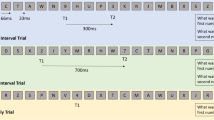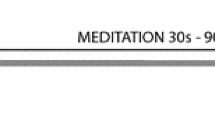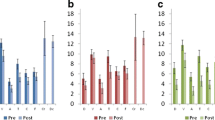Abstract
Objectives
Long-term meditation practice affects the brain’s ability to sustain attention. However, how this occurs is not well understood. Electroencephalography (EEG) studies have found that during dichotic oddball listening tasks, experienced meditators displayed altered attention-related neural markers including theta phase synchronization (TPS) and event-related potentials (ERP; P200 and P300) to target tones while meditating compared to resting, and compared to non-meditators after intensive meditation interventions. Research is yet to establish whether the changes in the aforementioned neural markers are trait changes which may be observable in meditators irrespective of practice setting.
Methods
The present study expanded on previous research by comparing EEG measures from a dichotic oddball task in a sample of community-based mindfulness meditators (n = 22) to healthy controls with no meditation experience (n = 22). To minimize state effects, neither group practiced meditation during/immediately prior to the EEG session.
Results
No group differences were observed in behavioural performance or either the global amplitude or distribution of theta phase synchronization, P200 or P300. Bayes factor analysis suggested evidence against group differences for the P200 and P300.
Conclusions
The results suggest that increased P200, P300, and TPS do not reflect trait-related changes in a community sample of mindfulness meditators. The present study used a larger sample size than previous research and power analyses suggested the study was sufficiently powered to detect differences. These results add nuance to our understanding of which processes are affected by meditation and the amount of meditation required to generate differences in specific neural processes.






Similar content being viewed by others
Data Availability
Participant self-report, behavioural, and EEG data are available at the Open Science Framework (https://doi.org/10.7910/DVN/APHLM1).
References
Aftanas, L. I., & Golocheikine, S. A. (2001). Human anterior and frontal midline theta and lower alpha reflect emotionally positive state and internalized attention: high-resolution EEG investigation of meditation. Neurosci Lett, 310(1), 57–60.
Allen, M., Dietz, M., Blair, K. S., van Beek, M., Rees, G., Vestergaard-Poulsen, P., & Roepstorff, A. (2012). Cognitive-affective neural plasticity following active-controlled mindfulness intervention. J Neurosci, 32(44), 15601.
Andreu, C. I., Moënne-Loccoz, C., López, V., Slagter, H. A., Franken, I. H., & Cosmelli, D. (2017). Behavioral and electrophysiological evidence of enhanced performance monitoring in meditators. Mindfulness, 8(6), 1603–1614.
Arns, M., Jongsma, M., & Kessels, R. (2014). P300 development across the lifespan: a systematic review and meta-analysis. PLoS One, 9(2), e87347.
Aschersleben, G. (2002). Temporal control of movements in sensorimotor synchronization. Brain Cogn, 48(1), 66–79.
Atchley, R., Klee, D., Memmott, T., Goodrich, E., Wahbeh, H., & Oken, B. (2016). Event-related potential correlates of mindfulness meditation competence. Neuroscience, 320, 83–92.
Badart, P., McDowall, J., & Prime, S. (2018). Multimodal sustained attention superiority in concentrative meditators compared to nonmeditators. Mindfulness, 9(3), 824–835.
Baer, R. A., Smith, G. T., Hopkins, J., Krietemeyer, J., & Toney, L. (2006). Using self-report assessment methods to explore facets of mindfulness. Assessment, 13(1), 27–45.
Baijal, S., & Srinivasan, N. (2010). Theta activity and meditative states: spectral changes during concentrative meditation. Int Q Cogn Sci, 11(1), 31–38.
Bailey, N., Freedman, G., Raj, K., Sullivan, C., Rogasch, N., Chung, S. W., & Fitzgerald, P. (2018). Mindfulness meditators show altered distributions of early and late neural activity markers of attention in a response inhibition task. bioRxiv, 396259.
Bailey, N. W., Raj, K., Freedman, G., Fitzgibbon, B., Rogasch, N. C., Van Dam, N., & Fitzgerald, P. (2019). Mindfulness meditators do not show differences in electrophysiological measures of error processing. Mindfulness, 10(2), 1–21.
Barron, E., Riby, L. M., Greer, J., & Smallwood, J. (2011). Absorbed in thought: the effect of mind wandering on the processing of relevant and irrelevant events. Psychol Sci, 22(5), 596–601.
Beck, A. T., Steer, R. A., & Brown, G. K. (1996). Beck Depression Inventory-II. San Antonio, 78(2), 490–498.
Biedermann, B., de Lissa, P., Mahajan, Y., Polito, V., Badcock, N., Connors, M. H., et al. (2016). Meditation and auditory attention: an ERP study of meditators and non-meditators. Int J Psychophysiol, 109(C), 63–70.
Brefczynski-Lewis, J. A., Lutz, A., Schaefer, H. S., Levinson, D. B., & Davidson, R. J. (2007). Neural correlates of attentional expertise in long-term meditation practitioners. Proceedings of the National Academy of Sciences of the United States, 104(27), 11483.
Britton, W. B., Davis, J. H., Loucks, E. B., Peterson, B., Cullen, B. H., Reuter, L., & Lindahl, J. R. (2018). Dismantling mindfulness-based cognitive therapy: creation and validation of 8-week focused attention and open monitoring interventions within a 3-armed randomized controlled trial. Behav Res Ther, 101, 92–107.
Cahn, B. R., & Polich, J. (2006). Meditation states and traits: EEG, ERP, and neuroimaging studies. Psychol Bull, 132(2), 180–211.
Cahn, B. R., & Polich, J. (2009). Meditation (Vipassana) and the P3a event-related brain potential. Int J Psychophysiol, 72(1), 51–60.
Cahn, B. R., Delorme, A., & Polich, J. (2013). Event-related delta, theta, alpha and gamma correlates to auditory oddball processing during Vipassana meditation. Soc Cogn Affect Neurosci, 8(1), 100–111.
Cardeña, E., Sjöstedt, J., & Marcusson-Clavertz, D. (2015). Sustained attention and motivation in Zen meditators and non-meditators. Mindfulness, 6(5), 1082–1087.
Chambers, R., Gullone, E., & Allen, N. B. (2009). Mindful emotion regulation: an integrative review. Clin Psychol Rev, 29(6), 560–572.
Choi, J. W., Cha, K. S., Choi, J. D., Jung, K.-Y., & Kim, K. H. (2015). Difficulty-related changes in inter-regional neural synchrony are dissociated between target and non-target processing. Brain Res, 1603(C), 114–123.
Davidson, R. (2005). Meditation and neuroplasticity: training your brain. Explore: The Journal of Science and Healing, 1(5), 380–388.
Delgado-Pastor, L. C., Perakakis, P., Subramanya, P., Telles, S., & Vila, J. (2013). Mindfulness (Vipassana) meditation: effects on P3b event-related potential and heart rate variability. Int J Psychophysiol, 90(2), 207–214.
Delorme, A., & Makeig, S. (2004). EEGLAB: an open source toolbox for analysis of single-trial EEG dynamics including independent component analysis. J Neurosci Methods, 134(1), 9–21.
Dimidjian, S., & Segal, Z. V. (2015). Prospects for a clinical science of mindfulness-based intervention. American Psychologist, 70(7), 593–620. https://doi.org/10.1037/a0039589.
Faul, F., Erdfelder, E., & Buchner, A. (2007). G*Power 3: a flexible statistical power analysis program for the social, behavioral, and biomedical sciences. Behav Res Methods, 39(2), 175–191.
Godfrin, K. A., & van Heeringen, C. (2010). The effects of mindfulness-based cognitive therapy on recurrence of depressive episodes, mental health and quality of life: a randomized controlled study. Behav Res Ther, 48(8), 738–746.
Goleman, D., & Davidson, R. (2017). Altered traits: science reveals how meditation changes your mind, brain, and body. New York: New York. Penguin.
Goyal, M., Singh, S., Sibinga, E. S., et al. (2014). Meditation programs for psychological stress and well-being: a systematic review and meta-analysis. JAMA Intern Med, 174(3), 357–368.
Grant, J. A., Courtemanche, J., Duerden, E. G., Duncan, G. H., & Rainville, P. (2010). Cortical thickness and pain sensitivity in Zen meditators. Emotion (Washington, D.C.), 10(1), 43.
Greenhouse, S. W., & Geisser, S. (1959). On methods in the analysis of profile data. Psychometrika, 24(2), 95–112.
Grossman, P., & Van Dam, N. T. (2011). Mindfulness, by any other name…: trials and tribulations of sati in western psychology and science. Contemporary Buddhism, 12(1), 219–239.
Gu, J., Strauss, C., Bond, R., & Cavanagh, K. (2015). How do mindfulness-based cognitive therapy and mindfulness-based stress reduction improve mental health and wellbeing? A systematic review and meta-analysis of mediation studies. Clin Psychol Rev, 37, 1–12.
Habermann, M., Weusmann, D., Stein, M., & Koenig, T. (2018). A student’s guide to randomization statistics for multichannel event-related potentials using Ragu. Frontiers in Neuroscience, 12.
Hanslmayr, S., Pastötter, B., Bäuml, K.-H., Gruber, S., Wimber, M., & Klimesch, W. (2008). The electrophysiological dynamics of interference during the Stroop task. J Cogn Neurosci, 20(2), 215–225.
Hasenkamp, W., & Barsalou, L. W. (2012). Effects of meditation experience on functional connectivity of distributed brain networks. Front Hum Neurosci, 6(2012), 1–14.
Hergueta, T., Baker, R., & Dunbar, G. C. (1998). The Mini-International Neuropsychiatric Interview (MINI): the development and validation of a structured diagnostic psychiatric interview for DSM-IVand ICD-10. J Clin Psychiatry, 59(20), 2233.
Hodgins, H. S., & Adair, K. C. (2010). Attentional processes and meditation. Conscious Cogn, 19(4), 872–878.
Hölzel, B. K., Lazar, S. W., Gard, T., Schuman-Olivier, Z., Vago, D. R., & Ott, U. (2011). How does mindfulness meditation work? Proposing mechanisms of action from a conceptual and neural perspective. Perspect Psychol Sci, 6(6), 537–559.
JASP Team (2019). JASP (Version 0.11.1) [Computer software].
Jeffreys, H. (1961). Theory of probability (3rd ed.). Oxford: Clarendon Press.
Jha, A. P., Krompinger, J., & Baime, M. J. (2007). Mindfulness training modifies subsystems of attention. Cogn Affect Behav Neurosci, 7(2), 109–119.
Jo, H.-G., Schmidt, S., Inacker, E., Markowiak, M., & Hinterberger, T. (2016). Meditation and attention: a controlled study on long-term meditators in behavioral performance and event-related potentials of attentional control. Int J Psychophysiol, 99, 33–39.
Jongsma, M. L. A., Eichele, T., Quiroga, R. Q., Jenks, K. M., Desain, P., Honing, H., & Van Rijn, C. M. (2005). Expectancy effects on omission evoked potentials in musicians and non-musicians. Psychophysiology, 42(2), 191–201.
Josefsson, T., & Broberg, A. (2011). Meditators and non-meditators on sustained and executive attentional performance. Ment Health Relig Cult, 14(3), 291–309.
Kabat-Zinn, J. (1994). Wherever you go. There you are: mindfulness meditation in everyday life. New York: Hyperion.
Kahana, M. J., Seelig, D., & Madsen, J. R. (2001). Theta returns. Curr Opin Neurobiol, 11(6), 739–744.
Kawasaki, M., Kitajo, K., & Yamaguchi, Y. (2014). Fronto-parietal and fronto-temporal theta phase synchronization for visual and auditory-verbal working memory. Front Psychol, 5, 200.
Keng, S.-L., Smoski, M. J., & Robins, C. J. (2011). Effects of mindfulness on psychological health: a review of empirical studies. Clin Psychol Rev, 31(6), 1041–1056.
Klimesch, W., Doppelmayr, M., Schimke, H., & Ripper, B. (1997). Theta synchronization and alpha desynchronization in a memory task. Psychophysiology, 34(2), 169–176.
Klimesch, W., Sauseng, P., Hanslmayr, S., Gruber, W., & Freunberger, R. (2007). Event-related phase reorganization may explain evoked neural dynamics. Neurosci Biobehav Rev, 31(7), 1003–1016.
Koenig, T., & Melie-garcía, L. (2010). A method to determine the presence of averaged event-related fields using randomization tests. Brain Topogr, 23(3), 233–242.
Koenig, T., Kottlow, M., Stein, M., & Melie-García, L. (2011). Ragu: a free tool for the analysis of EEG and MEG event-related scalp field data using global randomization statistics. Computational Intelligence and Neuroscience, 2011(2011), 14.
Lachaux, J., Rodriguez, E., Martinerie, J., & Varela, F. J. (1999). Measuring phase synchrony in brain signals. Human Brain Mapping, 8(4), 194–208. https://doi.org/10.1002/(SICI)1097-0193.
Lakey, C. E., Berry, D. R., & Sellers, E. W. (2011). Manipulating attention via mindfulness induction improves p300-based braincomputer interface performance. J Neural Eng, 8(2), 025019.
Lea, J., Cadman, L., & Philo, C. (2015). Changing the habits of a lifetime? Mindfulness meditation and habitual geographies. Cult Geogr, 22(1), 49–65.
Lee, G.-T., Lee, C., Kim, K. H., & Jung, K.-Y. (2014). Regional and inter-regional theta oscillation during episodic novelty processing. Brain Cogn, 90, 70–75.
Light, G. A., Williams, L. E., Minow, F., Sprock, J., Rissling, A., Sharp, R., & Braff, D. L. (2010). Electroencephalography (EEG) and event-related potentials (ERPs) with human participants. Current Protocols in Neuroscience, 6(52), Unit 6.25.21.
Lindholm, E., & Koriath, J. J. (1985). Analysis of multiple event related potential components in a tone discrimination task. International journal of psychophysiology : official journal of the International Organization of Psychophysiology, 3(2), 121.
Lutz, A., Slagter, H. A., Dunne, J. D., & Davidson, R. J. (2008). Attention regulation and monitoring in meditation. Trends Cogn Sci, 12(4), 163–169.
Lutz, A., Slagter, H. A., Rawlings, N. B., Francis, D. A., Greischar, L. L., & Davidson, J. D. (2009). Mental training enhances attentional stability: neural and behavioral evidence. J Neurosci, 29(42), 13418–13427.
Ma, S. H., & Teasdale, J. D. (2004). Mindfulness-based cognitive therapy for depression: replication and exploration of differential relapse prevention effects. J Consult Clin Psychol, 72(1), 31.
Mertens, R., & Polich, J. (1997). P300 from a single-stimulus paradigm: passive versus active tasks and stimulus modality. Electroencephalogr Clin Neurophysiol, 104(6), 488.
Miller, J. J., Fletcher, K., & Kabat-Zinn, J. (1995). Three-year follow-up and clinical implications of a mindfulness meditation-based stress reduction intervention in the treatment of anxiety disorders. Gen Hosp Psychiatry, 17(3), 192–200.
Oostenveld, R., Fries, P., Maris, E., & Schoffelen, J.-M. (2011). FieldTrip: open source software for advanced analysis of MEG, EEG, and invasive electrophysiological data. Computational Intelligence and Neuroscience, 2011(2011), 9.
Polich, J. (2007). Updating P300: an integrative theory of P3a and P3b. Clin Neurophysiol, 118(10), 2128–2148.
Rouder, J. N., Morey, R. D., Verhagen, J., Swagman, A. R., & Wagenmakers, E.-J. (2017). Bayesian analysis of factorial designs. Psychol Methods, 22(2), 304–321.
Richter, P., Werner, J., Heerlein, A., Kraus, A., & Sauer, H. (1998). On the validity of the Beck Depression Inventory. Psychopathology, 31(3), 160–168. https://doi.org/10.1159/000066239.
Sarang, S. P., & Telles, S. (2006). Changes in P300 following two yoga-based relaxation techniques. Int J Neurosci, 116(12), 1419–1430.
Schmertz, S., Anderson, P., & Robins, D. (2009). The relation between self-report mindfulness and performance on tasks of sustained attention. J Psychopathol Behav Assess, 31(1), 60–66.
Schoenberg, P. L., & Vago, D. R. (2019). Mapping meditative states and stages with electrophysiology: concepts, classifications, and methods. Curr Opin Psychol, 28, 211–217.
Schoenberg, P. L., Hepark, S., Kan, C., Barendregt, H. P., Buitelaar, J. K., & Speckens, A. (2013). Effects of mindfulness-based cognitive therapy on neurophysiological correlates of performance monitoring in adult attention-deficit/hyperactivity disorder. Clinical Neurophysiology, 125(7), 1407–1416. https://doi.org/10.1016/j.clinph.2013.11.031.
Simões, C., Jensen, O., Parkkonen, L., & Hari, R. (2003). Phase locking between human primary and secondary somatosensory cortices. Proc Natl Acad Sci U S A, 100(5), 2691–2694. https://doi.org/10.1073/pnas.0437944100.
Slagter, H. A., Lutz, A., Greischar, L. L., Francis, A. D., Nieuwenhuis, S., Davis, J. M., & Davidson, R. J. (2007). Mental training affects distribution of limited brain resources. PLoS Biol, 5(6), e138.
Slagter, H. A., Lutz, A., Greischar, L. L., Nieuwenhuis, S., & Davidson, R. J. (2009). Theta phase synchrony and conscious target perception: impact of intensive mental training. J Cogn Neurosci, 21(8), 1536–1549.
Steer, R. A., & Beck, A. T. (1997). Beck Anxiety Inventory.
Tang, Y. Y., Hölzel, B. K., & Posner, M. I. (2015). The neuroscience of mindfulness meditation. Nature Reviews. Neuroscience, 16(4), 213–225.
Taylor, V. A., Grant, J., Daneault, V., Scavone, G., Breton, E., Roffe-Vidal, S., & Beauregard, M. (2011). Impact of mindfulness on the neural responses to emotional pictures in experienced and beginner meditators. NeuroImage, 57(4), 1524–1533.
Thomas, J. W., & Cohen, M. (2014). A methodological review of meditation research. Frontiers in Psychiatry, 5, 74–74.
Tomasino, B., & Fabbro, F. (2016). Increases in the right dorsolateral prefrontal cortex and decreases the rostral prefrontal cortex activation after-8 weeks of focused attention based mindfulness meditation. Brain Cogn, 102, 46–54.
Tomasino, B., Fregona, S., Skrap, M., & Fabbro, F. (2012). Meditation-related activations are modulated by the practices needed to obtain it and by the expertise: an ALE meta-analysis study. Front Hum Neurosci, 6, 346.
Ueno, T., Hirano, S., Hirano, Y., Kanba, S., Kobayashi, S., & Onitsuka, T. (2009). Locked to stimulation: Significance level of the phase-locking factor. 2nd International Congress on Image and Signal Processing, 1–4. https://doi.org/10.1109/CISP.2009.5304010.
Van Dam, N. T., van Vugt, M. K., Vago, D. R., Schmalzl, L., Saron, C. D., Olendzki, A., & Meyer, D. E. (2018). Mind the hype: a critical evaluation and prescriptive agenda for research on mindfulness and meditation. Perspect Psychol Sci, 13(1), 36–61.
Varela, F., Lachaux, J., Rodriguez, E., & Martinerie, J. (2001). The brainweb: Phase synchronization and large-scale integration. Nature Reviews Neuroscience, 2(4), 229–239. https://doi.org/10.1038/35067550.
Funding
The study was funded by an Alfred Research Trust Small Grant Scheme (T11801). PBF is supported by a National Health and Medical Research Council of Australia Practitioner Fellowship (6069070).
Author information
Authors and Affiliations
Contributions
JRP performed the data collection and data analysis, and wrote the paper. HG performed data collection. OB performed data collection and assisted with editing the final manuscript. BF, ME, ATH, NVD, GH, and PBF had input into study design, supported data collection or analysis, and had intellectual input and editing input into the final manuscript. NWB designed and oversaw the study and provided technical expertise and training in data analysis as well as with writing the paper.
Corresponding author
Ethics declarations
Ethical Approval
All procedures performed in the study involving human participants were in accordance with the ethical standards of both The Alfred Hospital and Monash University ethical research committee and with the 1964 Helsinki declaration and its later amendments.
Conflict of Interest
PBF has received equipment for research from MagVenture A/S, Medtronic Ltd., Cervel Neurotech, and Brainsway Ltd. and funding for research from Neuronetics and Cervel Neurotech. PBF is on the scientific advisory board for Bionomics Ltd. The other authors declare that they have no conflicts of interest.
Informed Consent
Informed consent was obtained from all individual participants included in the study.
Additional information
Publisher’s Note
Springer Nature remains neutral with regard to jurisdictional claims in published maps and institutional affiliations.
Electronic Supplementary Material
ESM 1
(DOCX 381 kb)
Rights and permissions
About this article
Cite this article
Payne, J.R., Baell, O., Geddes, H. et al. Experienced Meditators Exhibit No Differences to Demographically Matched Controls in Theta Phase Synchronization, P200, or P300 During an Auditory Oddball Task. Mindfulness 11, 643–659 (2020). https://doi.org/10.1007/s12671-019-01287-4
Published:
Issue Date:
DOI: https://doi.org/10.1007/s12671-019-01287-4




